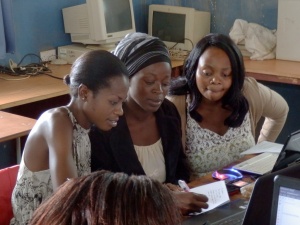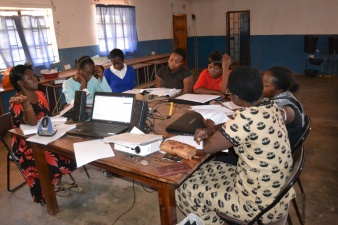OER4Schools/Overview: Difference between revisions
m (Unit 1 and 2 revisions) |
No edit summary |
||
| (20 intermediate revisions by 2 users not shown) | |||
| Line 1: | Line 1: | ||
{{OER4S | {{OER4S | ||
|title={{Get session title}} | |title={{Get session title}} | ||
|session=0 | |session=0.1 | ||
}} | }} | ||
'''Introduction'''. This is a professional learning resource for teachers, focusing on interactive pedagogy for teaching with and without Information and Communication Technology (ICT). A key feature of this resource is the use of video as a stimulus for discussion. The video used has been produced mainly in the Zambian primary school context, but we anticipate other video materials to become available, and we hope the material will be useful in other contexts too. | '''Introduction'''. This is a professional learning resource for teachers, focusing on interactive pedagogy for teaching with and without Information and Communication Technology (ICT). A key feature of this resource is the use of video as a stimulus for discussion. The video used has been produced mainly in the Zambian primary school context, but we anticipate other video materials to become available, and we hope the material will be useful in other contexts too. | ||
'''Interactive teaching'''. The resource introduces and illustrates interactive teaching – using interactive teaching techniques itself! These include asking users to brainstorm, reflect, collaborate, discuss, make personal sense of new ideas and try out new classroom practices. "Interactive" in this context does not mean technically interactive (in the sense of interacting with a computer), but pedagogically interactive: learners are interacting with each other and the teacher rather than being passive consumers of content. | '''Interactive teaching'''. The resource introduces and illustrates interactive teaching – using interactive teaching techniques itself! These include asking users to brainstorm, reflect, collaborate, discuss, make personal sense of new ideas and try out new classroom practices. "Interactive" in this context does not mean technically interactive (in the sense of interacting with a computer), but pedagogically interactive: learners are interacting with each other and the teacher rather than being passive consumers of content. | ||
{{ | The programme draws on a number of techniques and ideas, include reflective practice (the cycle of "{{activitytag|Plan-Teach-Reflect}}"), [[OER4Schools/LfL|Leadership for Learning]], the "[[OER4Schools/Index for Inclusion|Index for Inclusion]]", and the [[OER4Schools/Most Significant Change Technique|"most significant change" technique]] (a participatory way of identifying significant changes). | ||
'''Modes of use.''' The resource can be used in different ways, depending on your circumstances. It supports different modes of learning, such as | '''Modes of use.''' The resource can be used in different ways, depending on your circumstances. It supports different modes of learning, such as | ||
| Line 22: | Line 15: | ||
* use by staff of a whole school, or for | * use by staff of a whole school, or for | ||
* blended learning – as part of a distance learning course with some face-to-face workshops. | * blended learning – as part of a distance learning course with some face-to-face workshops. | ||
<center>[[Image:oer4s Ts working together.jpg|300px]] [[Image:oer4s Teachers in workshop.jpg|338px]]</center> | |||
The section [[OER4Schools/How_to_use_this_resource|How to use this resource]] gives further information about using the material, for instance for individual, self-paced learning, or for use by small, informal groups of colleagues, while [[OER4Schools/How_to_run_workshops|the page on how to facilitate workshops]] provides an introduction on how you might run workshop sessions. | |||
'''Content'''. The resource consists of 6 units, including one introductory unit, 4 topic-based units, as well as a concluding unit called “Sharing the vision”. The units are | '''Content'''. The resource consists of 6 units, including one introductory unit, 4 topic-based units, as well as a concluding unit called “Sharing the vision”. The units are | ||
| Line 37: | Line 35: | ||
General “teacher” text is for use in a workshop or by individuals or classes using the resource (“users”) to support their own professional learning. Users could have that text in front of them on a projector or printed out. It might effectively be used as a series of slides or a handout, that provide a thread through the resource or workshop. | General “teacher” text is for use in a workshop or by individuals or classes using the resource (“users”) to support their own professional learning. Users could have that text in front of them on a projector or printed out. It might effectively be used as a series of slides or a handout, that provide a thread through the resource or workshop. | ||
'''Licence'''. This resource is openly accessible under a Creative Common licence so that it can be freely distributed, copied or adapted. To facilitate this in practice, it will be available in a number of formats (online and offline), appropriate to the varied sub-Saharan environments in which teachers find themselves. Please check our website http:// | '''Licence'''. This resource is openly accessible under a Creative Common licence so that it can be freely distributed, copied or adapted. To facilitate this in practice, it will be available in a number of formats (online and offline), appropriate to the varied sub-Saharan environments in which teachers find themselves. Please check our website http://www.oer4schools.org for available formats. | ||
In addition, our videos are available from our YouTube site, http://www.youtube.com/user/OER4Schools. | In addition, our videos are available from our YouTube site, http://www.youtube.com/user/OER4Schools. | ||
If you do not have access to the internet, then do speak to the person who gave you these materials about how to find out more information. | If you do not have access to the internet, then do speak to the person who gave you these materials about how to find out more information. | ||
{{OER4S_NextSession}} | |||
Latest revision as of 18:04, 13 May 2014
Introduction. This is a professional learning resource for teachers, focusing on interactive pedagogy for teaching with and without Information and Communication Technology (ICT). A key feature of this resource is the use of video as a stimulus for discussion. The video used has been produced mainly in the Zambian primary school context, but we anticipate other video materials to become available, and we hope the material will be useful in other contexts too.
Interactive teaching. The resource introduces and illustrates interactive teaching – using interactive teaching techniques itself! These include asking users to brainstorm, reflect, collaborate, discuss, make personal sense of new ideas and try out new classroom practices. "Interactive" in this context does not mean technically interactive (in the sense of interacting with a computer), but pedagogically interactive: learners are interacting with each other and the teacher rather than being passive consumers of content.
The programme draws on a number of techniques and ideas, include reflective practice (the cycle of "Plan-Teach-Reflect(a)"), Leadership for Learning, the "Index for Inclusion", and the "most significant change" technique (a participatory way of identifying significant changes).
Modes of use. The resource can be used in different ways, depending on your circumstances. It supports different modes of learning, such as
- individual, self-paced learning,
- use by small, informal groups of colleagues,
- use with a class of students on a formally taught pre-service or in-service course,
- use by staff of a whole school, or for
- blended learning – as part of a distance learning course with some face-to-face workshops.


The section How to use this resource gives further information about using the material, for instance for individual, self-paced learning, or for use by small, informal groups of colleagues, while the page on how to facilitate workshops provides an introduction on how you might run workshop sessions.
Content. The resource consists of 6 units, including one introductory unit, 4 topic-based units, as well as a concluding unit called “Sharing the vision”. The units are
- Unit 1: Introduction to interactive teaching and the use of ICT
- Unit 2: Whole class dialogue & effective questioning
- Unit 3: Group work
- Unit 4: Assessment for learning and lesson pacing
- Unit 5: Enquiry-based learning and project work
- Unit 6: Into the future
See the detailed outline for more information.
Format. Each unit includes an introduction to that unit (providing an overview of the topic itself), and a number of activities, including
- Personal reflections on textual material about interactive teaching,
- Workshop activities based on discussing video, audio and photographical stimuli,
- School-based classroom activities for teachers to try out during lessons,
- Guidance for teacher reflection (following their lessons),
- Educator reflections – for teacher educators who might be using this resource to run face-to-face, blended, or distance learning programs.
Versions. The resource is available as a version for participants, as well as a version for facilitators with additional notes. General “teacher” text is for use in a workshop or by individuals or classes using the resource (“users”) to support their own professional learning. Users could have that text in front of them on a projector or printed out. It might effectively be used as a series of slides or a handout, that provide a thread through the resource or workshop.
Licence. This resource is openly accessible under a Creative Common licence so that it can be freely distributed, copied or adapted. To facilitate this in practice, it will be available in a number of formats (online and offline), appropriate to the varied sub-Saharan environments in which teachers find themselves. Please check our website http://www.oer4schools.org for available formats. In addition, our videos are available from our YouTube site, http://www.youtube.com/user/OER4Schools. If you do not have access to the internet, then do speak to the person who gave you these materials about how to find out more information.

